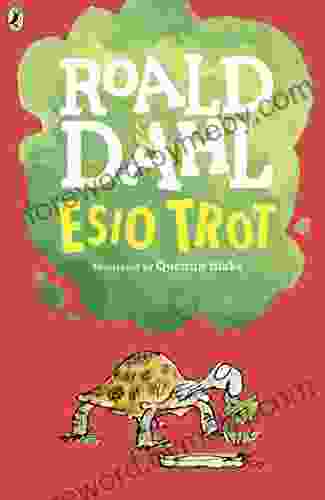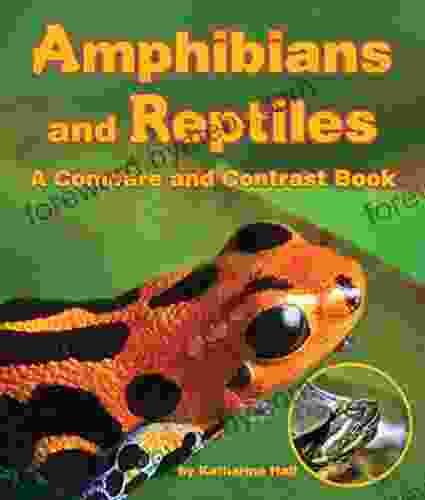Amphibians and Reptiles: A Comprehensive Comparison and Contrast

The natural world is teeming with an astonishing diversity of life, and among its most captivating inhabitants are the enigmatic amphibians and reptiles. These two groups of animals, though often intertwined in our imaginations, possess distinct characteristics and lifestyles that set them apart.
5 out of 5
| Language | : | English |
| File size | : | 8747 KB |
| Screen Reader | : | Supported |
| Print length | : | 32 pages |
| Lending | : | Enabled |
In this article, we will embark on a journey to explore the fascinating world of amphibians and reptiles. We will delve into their evolutionary history, uncovering their common ancestry and the unique adaptations that have shaped their respective lineages. We will examine their physical traits, comparing their anatomy, skin texture, and locomotion. We will investigate their habitats, exploring the diverse environments they call home and the adaptations that allow them to thrive in these conditions.
Furthermore, we will delve into their reproductive strategies, comparing their unique methods of egg-laying and development. We will uncover their feeding habits, examining the different prey they consume and the adaptations that enable them to capture and ingest their food. Finally, we will discuss their conservation status, shedding light on the threats they face and the efforts being made to protect these extraordinary creatures.
Shared Similarities
Before we delve into their differences, it is essential to acknowledge the shared similarities that unite amphibians and reptiles as members of the vertebrate family. Both groups possess a backbone, which provides structural support and facilitates movement. They also share a common evolutionary history, with amphibians being considered the ancestors of reptiles.
Additionally, both amphibians and reptiles are ectothermic, meaning they rely on external sources to regulate their body temperature. This characteristic influences their behavior and distribution, as they often seek out warm environments to bask in the sun.
Key Differences
Despite their shared similarities, amphibians and reptiles exhibit a range of distinct characteristics that set them apart. These differences extend across various aspects of their biology, including their habitat preferences, physical traits, reproductive strategies, and evolutionary history.
Habitat Preferences
One of the most striking differences between amphibians and reptiles is their habitat preferences. Amphibians, as their name suggests, are closely tied to water throughout their lives. Many species of amphibians, such as frogs and salamanders, spend their larval stage in aquatic environments, where they breathe through gills and rely on water for moisture. Even as adults, many amphibians prefer to live in or near water bodies, as their skin requires moisture to prevent desiccation.
In contrast, reptiles are more versatile in their habitat preferences. They can be found in a wide range of environments, including deserts, forests, grasslands, and even marine habitats. Reptiles have evolved specialized adaptations, such as scales and water-conserving mechanisms, that allow them to thrive in drier conditions than amphibians.
Physical Traits
The physical traits of amphibians and reptiles also reflect their distinct lifestyles and adaptations. Amphibians typically have smooth, moist skin that facilitates gas exchange through cutaneous respiration. They also possess webbed feet and powerful hind legs, which aid in swimming and leaping.
Reptiles, on the other hand, have dry, scaly skin that provides protection from desiccation and injury. They also have well-developed limbs for locomotion, ranging from the swift and agile movements of lizards to the powerful crawling of snakes.
Reproductive Strategies
The reproductive strategies of amphibians and reptiles further highlight their differences. Amphibians typically lay their eggs in water, and their larvae undergo a process of metamorphosis, transforming from aquatic juveniles into terrestrial adults. Frogs, for instance, lay their eggs in gelatinous masses in water, and their tadpoles eventually develop into adult frogs with lungs and legs.
Reptiles, on the other hand, typically lay their eggs on land, with some species exhibiting live birth. Their eggs are amniotic, meaning they are enclosed in a protective membrane that contains nutrients and oxygen. This adaptation allows reptiles to reproduce in drier environments, as their eggs do not require an aquatic environment for development.
Evolutionary History
The evolutionary history of amphibians and reptiles reveals a fascinating tale of adaptation and diversification. Amphibians emerged as the first vertebrates to venture onto land, evolving from lobe-finned fishes during the Devonian period, approximately 360 million years ago. They were the dominant terrestrial vertebrates for millions of years, until the rise of reptiles during the Carboniferous period, around 300 million years ago.
Reptiles, with their advanced adaptations for terrestrial life, eventually outcompeted amphibians in many habitats. However, amphibians persisted in certain niches, such as wetlands and moist forests, where their unique adaptations continued to provide an advantage.
The world of amphibians and reptiles is a captivating tapestry of diversity and adaptation. From their shared ancestry to their unique characteristics, these two groups of animals have played a pivotal role in shaping the history of life on Earth.
Their differences and similarities offer a glimpse into the incredible plasticity of life and the remarkable evolutionary journeys that have shaped our planet's biodiversity. By understanding and appreciating these fascinating creatures, we not only gain a deeper understanding of the natural world but also foster a sense of wonder and respect for the incredible diversity of life that surrounds us.
5 out of 5
| Language | : | English |
| File size | : | 8747 KB |
| Screen Reader | : | Supported |
| Print length | : | 32 pages |
| Lending | : | Enabled |
Do you want to contribute by writing guest posts on this blog?
Please contact us and send us a resume of previous articles that you have written.
 Book
Book Novel
Novel Page
Page Chapter
Chapter Text
Text Story
Story Genre
Genre Reader
Reader Library
Library Paperback
Paperback E-book
E-book Magazine
Magazine Newspaper
Newspaper Paragraph
Paragraph Sentence
Sentence Bookmark
Bookmark Shelf
Shelf Glossary
Glossary Bibliography
Bibliography Foreword
Foreword Preface
Preface Synopsis
Synopsis Annotation
Annotation Footnote
Footnote Manuscript
Manuscript Scroll
Scroll Codex
Codex Tome
Tome Bestseller
Bestseller Classics
Classics Library card
Library card Narrative
Narrative Biography
Biography Autobiography
Autobiography Memoir
Memoir Reference
Reference Encyclopedia
Encyclopedia Eugene Cernan
Eugene Cernan Miya Kressin
Miya Kressin Farley Mowat
Farley Mowat Jonathan White
Jonathan White Flora Warren Seymour
Flora Warren Seymour Francis M Higman
Francis M Higman James Green
James Green Evan S Connell
Evan S Connell Gayle Kassing
Gayle Kassing Erwin Panofsky
Erwin Panofsky Jo Wheeler
Jo Wheeler Eva Tulene Watt
Eva Tulene Watt Kathryn Short
Kathryn Short Eve Blossom
Eve Blossom Frederick Vaughan
Frederick Vaughan Eugene O Neill
Eugene O Neill Nik Mahon
Nik Mahon Franz Sales Meyer
Franz Sales Meyer Franklin W Dixon
Franklin W Dixon Zhongwen Fu
Zhongwen Fu
Light bulbAdvertise smarter! Our strategic ad space ensures maximum exposure. Reserve your spot today!

 Jayson PowellFoundations In Craniosacral Biodynamics Volume Two: Unraveling the Secrets of...
Jayson PowellFoundations In Craniosacral Biodynamics Volume Two: Unraveling the Secrets of...
 Albert ReedThe Joy of Gratitude: Nurturing Happiness in Young Readers with 'About Being...
Albert ReedThe Joy of Gratitude: Nurturing Happiness in Young Readers with 'About Being...
 Richard SimmonsGalactic Hot Dogs: The Wiener Strikes Back - A Culinary Adventure Through the...
Richard SimmonsGalactic Hot Dogs: The Wiener Strikes Back - A Culinary Adventure Through the... Alvin BellFollow ·12.6k
Alvin BellFollow ·12.6k VoltaireFollow ·19.4k
VoltaireFollow ·19.4k Jim CoxFollow ·15.2k
Jim CoxFollow ·15.2k Terry BellFollow ·15.5k
Terry BellFollow ·15.5k Vic ParkerFollow ·16.4k
Vic ParkerFollow ·16.4k Roald DahlFollow ·9.6k
Roald DahlFollow ·9.6k Sam CarterFollow ·13k
Sam CarterFollow ·13k Andy ColeFollow ·13.7k
Andy ColeFollow ·13.7k

 Al Foster
Al FosterDive into the Enchanting World of Manatees: An...
Unveiling the Secrets of the Gentle...

 Isaac Mitchell
Isaac MitchellThe Farm Reggie and Friends: US Version - A Captivating...
A Heartwarming Tale that Embraces...

 Esteban Cox
Esteban CoxThe Interior Design Handbook: Your Comprehensive Guide to...
Are you ready to...

 William Wordsworth
William WordsworthFall Head Over Heels for "Esio Trot" by Roald Dahl: A...
Prepare to be charmed, amused, and utterly...

 Caleb Carter
Caleb CarterBlack Clover Vol Light Frida Ramstedt: A Thrilling...
Prepare to be spellbound by...

 Richard Simmons
Richard SimmonsFantastic Mr. Fox: A Literary Adventure That Captivates...
In the realm...
5 out of 5
| Language | : | English |
| File size | : | 8747 KB |
| Screen Reader | : | Supported |
| Print length | : | 32 pages |
| Lending | : | Enabled |




